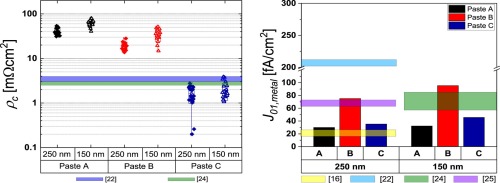当前位置:
X-MOL 学术
›
Sol. Energy
›
论文详情
Our official English website, www.x-mol.net, welcomes your feedback! (Note: you will need to create a separate account there.)
Characterization of screen printed and fire-through contacts on LPCVD based passivating contacts in monoPoly™ solar cells
Solar Energy ( IF 6.7 ) Pub Date : 2020-05-01 , DOI: 10.1016/j.solener.2020.03.087 Pradeep Padhamnath , Jammaal Kitz Buatis , Ankit Khanna , Nitin Nampalli , Naomi Nandakumar , Vinodh Shanmugam , Armin G. Aberle , Shubham Duttagupta
Solar Energy ( IF 6.7 ) Pub Date : 2020-05-01 , DOI: 10.1016/j.solener.2020.03.087 Pradeep Padhamnath , Jammaal Kitz Buatis , Ankit Khanna , Nitin Nampalli , Naomi Nandakumar , Vinodh Shanmugam , Armin G. Aberle , Shubham Duttagupta

|
Abstract In this work we have characterized screen-printed passivating contacts formed by different commercially available fire-through pastes on phosphorus doped (n+) polysilicon (poly-Si) layers at the rear side of monoPoly™ solar cells. Extremely low recombination current density under metal contacts (J01,metal) of 35–45 fA/cm2 and excellent specific contact resistivity (ρc) values of ~ 1.3 mΩ-cm2 are obtained for two different thicknesses of poly-Si (150 nm and 250 nm) used in this work. We demonstrate that, although the metal induced recombination increases with reducing thickness of the poly-Si layer, thinner poly-Si layers can lead to higher efficiencies on account of reduced parasitic absorption leading to higher cell current. A champion efficiency of 22.6% is reported for busbarless monoPoly™ cells with the best performing fire-through (FT) paste on large area (244.3 cm2) commercially available Czochralski grown Si wafers.
中文翻译:

monoPoly™ 太阳能电池中基于 LPCVD 的钝化触点上的丝网印刷和烧穿触点的表征
摘要 在这项工作中,我们表征了由不同的市售烧穿浆料在 monoPoly™ 太阳能电池背面的磷掺杂 (n+) 多晶硅 (poly-Si) 层上形成的丝网印刷钝化触点。对于两种不同厚度的多晶硅(150 nm 和 250 nm)在这项工作中使用。我们证明,虽然金属诱导的复合随着多晶硅层厚度的减小而增加,但由于寄生吸收减少导致电池电流更高,因此更薄的多晶硅层可以导致更高的效率。冠军效率22。
更新日期:2020-05-01
中文翻译:

monoPoly™ 太阳能电池中基于 LPCVD 的钝化触点上的丝网印刷和烧穿触点的表征
摘要 在这项工作中,我们表征了由不同的市售烧穿浆料在 monoPoly™ 太阳能电池背面的磷掺杂 (n+) 多晶硅 (poly-Si) 层上形成的丝网印刷钝化触点。对于两种不同厚度的多晶硅(150 nm 和 250 nm)在这项工作中使用。我们证明,虽然金属诱导的复合随着多晶硅层厚度的减小而增加,但由于寄生吸收减少导致电池电流更高,因此更薄的多晶硅层可以导致更高的效率。冠军效率22。


























 京公网安备 11010802027423号
京公网安备 11010802027423号